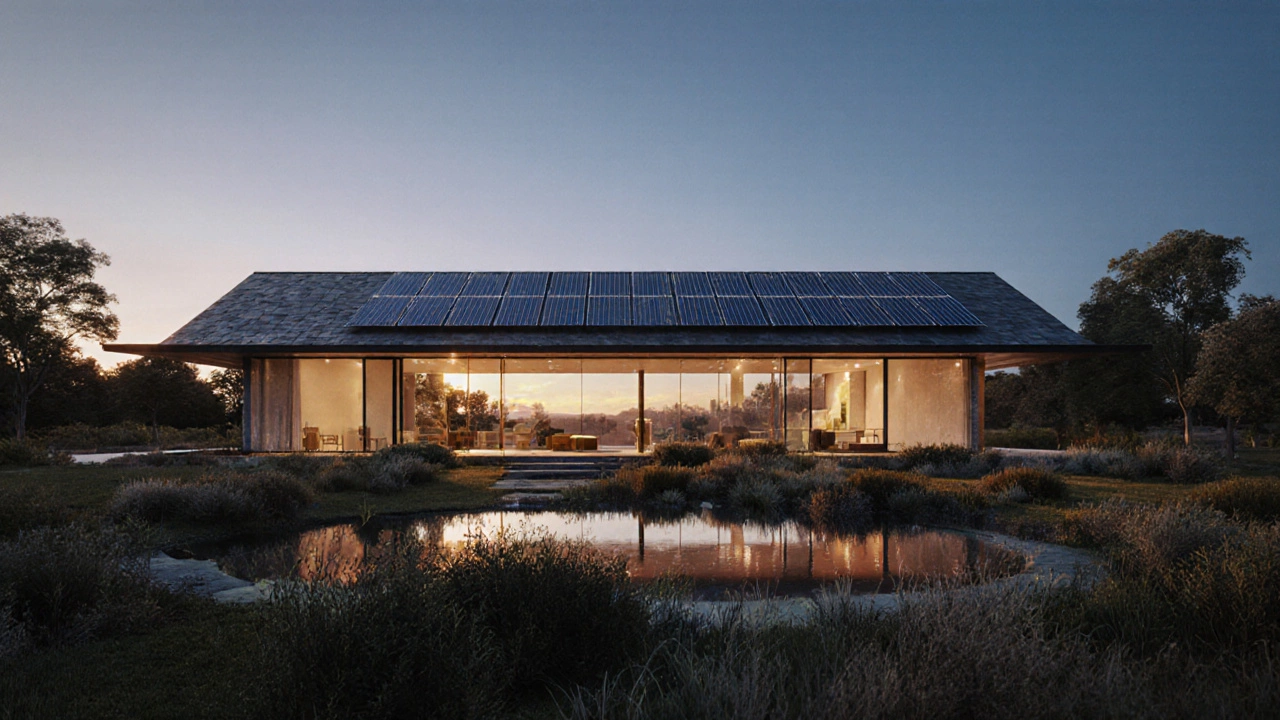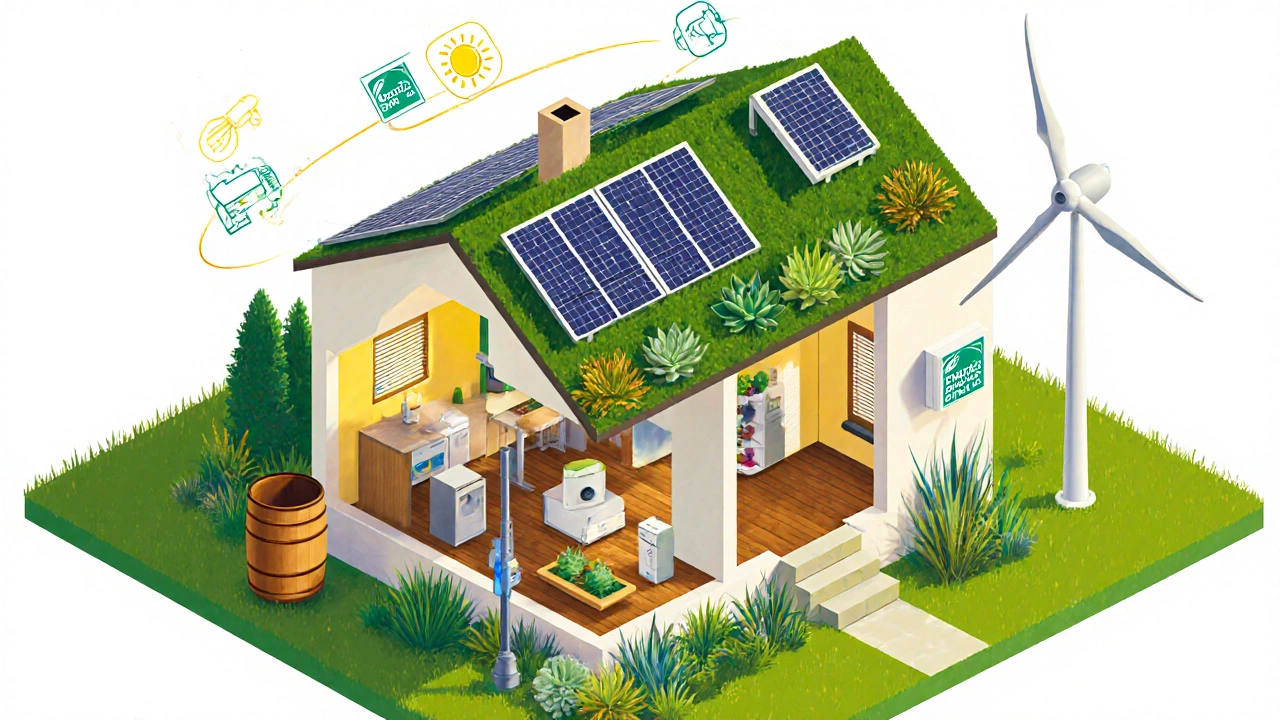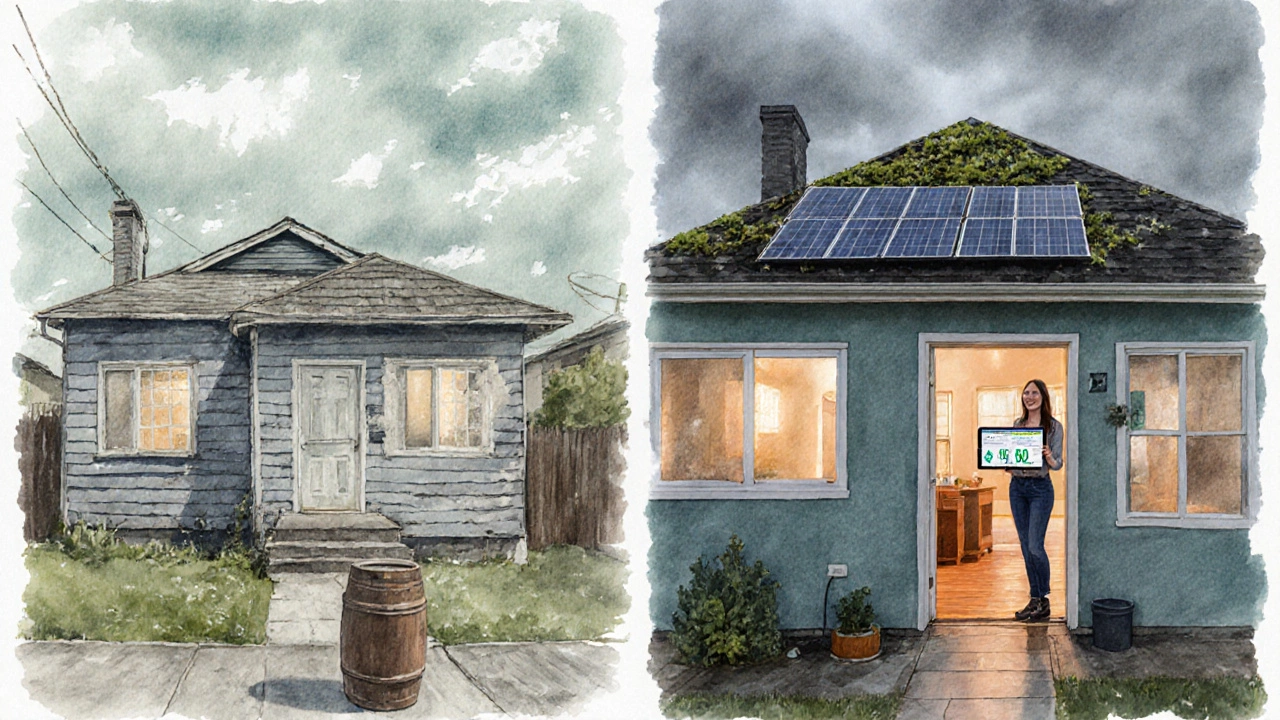What Makes a Home Truly Eco‑Friendly? A Complete Guide

Eco‑Friendly Home Energy Calculator
Estimate Your Home's Eco-Friendly Savings
Use this tool to calculate potential energy savings, carbon reduction, and payback periods for eco-friendly home upgrades based on real data from the guide.
Your Current Energy Usage
Upgrade Selection
Your Energy Savings Estimate
Estimated Annual Energy Savings
0 kWh
Reduces your consumption by 0%
Cost Savings
$0
CO₂ Reduction
0 kg
Payback Period
0 years
Based on average Canadian electricity rates
Recommended Next Steps
Increases home comfort and reduces heating costs by 25-30%.
Provides renewable energy generation with a payback of 6-10 years.
Eliminates fossil fuel use for heating and cooling.
When you hear the phrase eco-friendly home, you might picture solar panels or a tiny cabin in the woods. In reality, the most eco‑friendly home blends design, materials, energy, water, and technology into a living space that minimizes carbon impact while staying comfortable and beautiful. Below is a practical roadmap that shows exactly what a green house looks like, how to assess its sustainability, and the steps you can take today to move toward a zero‑carbon lifestyle.
Key Takeaways
- Eco‑friendly homes are defined by net‑zero energy use, sustainable materials, and water‑saving systems.
- Passive solar design, renewable energy, and smart automation are the core performance pillars.
- A simple checklist can help you audit an existing house and prioritize upgrades.
- Many upgrades pay for themselves within 5‑10 years through lower utility bills.
- Local climate, budget, and lifestyle shape which green features make the most sense.
Defining an Eco‑Friendly Home
Eco-friendly home is a residential building designed to reduce environmental impact across its entire lifecycle, from construction to demolition, by using renewable energy, sustainable materials, water efficiency, and indoor health‑focused design. It isn’t just a house with a few green gadgets; it’s a holistic system where each component supports the others to achieve net‑zero carbon emissions.
Core Components of a Sustainable House
Think of a green home as a puzzle. Each piece-energy, water, materials, indoor air, and technology-fits together to create a low‑impact picture.
1. Passive Solar Design
Passive solar design captures the sun’s heat in winter and shades it in summer without relying on mechanical systems. Key strategies include orienting the building’s longest side toward the equator, using overhangs, and selecting high‑performance glazing.
2. Net‑Zero Energy
Net-zero energy means the home produces as much renewable electricity as it consumes over a year. Solar photovoltaic (PV) arrays, wind turbines, or community solar subscriptions are common sources.
3. Renewable Energy Systems
Solar PV, rooftop wind, and geothermal heat pumps are the primary renewable energy systems for residential use. In Vancouver’s mild climate, a 6‑kW solar array paired with a heat‑pump water heater can cover most heating and electricity needs.
4. Sustainable Building Materials
Choosing materials with low embodied carbon is crucial. Sustainable building materials include reclaimed wood, bamboo flooring, recycled steel, and low‑VOC (volatile organic compounds) paints. These reduce the carbon released during manufacturing and improve indoor air quality.
5. Water Reclamation & Efficiency
A water reclamation system captures rainwater and gray water for irrigation and toilet flushing. Dual‑flush toilets, low‑flow fixtures, and smart irrigation controllers shave off up to 40% of household water use.
6. Energy‑Efficient Appliances
Appliances rated ENERGY STAR or equivalent consume far less electricity. Pairing them with a smart home hub ensures they run during off‑peak hours, further lowering the grid impact.
7. Green Roofs & Living Walls
A green roof provides insulation, stormwater absorption, and habitat for pollinators. Even a modest 200‑square‑foot vegetated roof can cut heating bills by 10‑15% in colder climates.
8. Smart Home Automation
Automation bridges all the other systems. Smart home automation monitors energy use, adjusts blinds for solar gain, and alerts you to leaks, making daily operations more efficient.

How to Assess Your Home’s Eco‑Score
Before you invest, run a quick audit. Below is a simple table that compares a typical conventional home with an eco‑friendly benchmark across key metrics.
| Metric | Typical Home | Eco‑Friendly Target |
|---|---|---|
| Annual Energy Use (kWh) | 12,000-15,000 | ≤5,000 (net‑zero) |
| CO₂ Emissions (kg) | 8,000-10,000 | 0-500 (offset) |
| Water Use (gallons/day) | 150-200 | ≤80 |
| Embodied Carbon (kg CO₂e/m²) | 350-500 | ≤150 (recycled/low‑carbon materials) |
| Indoor Air Quality Index | Variable, often poor | Consistentlygood (low‑VOC finishes, ventilation) |
Step‑by‑Step Checklist to Green Your Home
- Evaluate the envelope. Check insulation R‑values, window glazing, and air sealing. Upgrading to R‑30 walls and double‑pane low‑E glass often yields the highest savings.
- Map solar potential. Use a free online solar calculator to estimate how many panels fit on your roof. In Vancouver, a 6‑kW system can generate ~7,800kWh/year.
- Install renewable energy. Start with solar PV; add a battery storage unit if you want backup or want to shift load to peak‑price periods.
- Upgrade appliances. Swap old refrigerators, dishwashers, and HVAC units for ENERGY STAR models.
- Implement water‑saving fixtures. Replace toilets with dual‑flush models, install aerated faucets, and consider a rainwater tank sized for your roof area.
- Choose sustainable materials. For any remodel, source reclaimed wood, FSC‑certified lumber, or recycled‑content drywall.
- Add green roof or shading. If structural load permits, install a vegetated roof. Otherwise, add pergolas or shade sails to cut summer cooling.
- Integrate smart controls. Connect thermostats, lighting, and blinds to a central hub that learns your habits and optimizes energy use.
- Monitor and certify. Track performance with an energy monitor. Consider a certification like LEED for Homes or Canada's Passive House standard to validate your effort.
Common Pitfalls and How to Avoid Them
- Over‑specifying technology. Installing a fancy automation system without proper insulation wastes power. Insulate first, then automate.
- Ignoring climate. Passive solar works great in temperate zones but can cause overheating in hot regions. Use adjustable shading and thermal mass to balance gains.
- Choosing low‑cost, high‑embodied‑carbon materials. Cheap concrete blocks may save money upfront but lock in high carbon for decades. Look for low‑carbon concrete alternatives.
- Skipping proper ventilation. Airtight homes need mechanical ventilation with heat recovery (MVHR) to keep indoor air fresh without losing heat.

Real‑World Example: A Vancouver Retrofit
Meet Maya, a Vancouver homeowner who turned her 1970s bungalow into a net‑zero gem. She started by adding spray‑foam insulation to achieve R‑38 walls and installed triple‑pane windows. A 5‑kW solar array on her roof now covers 90% of her electricity use. She replaced her gas furnace with an air‑source heat pump, installed a rain barrel that supplies her garden, and chose reclaimed hardwood flooring. After two years, Maya’s utility bills dropped from $200/month to $30/month, and her home’s carbon footprint fell from 9tonnes/year to under 1tonne, qualifying her for the Passive House certification.
Future Trends Shaping Eco‑Friendly Homes
Even if you’re not ready to overhaul your house today, stay aware of emerging technologies that will make green living easier:
- Solar tiles that blend into roof shingles, reducing aesthetic concerns.
- Advanced battery chemistries like solid‑state batteries offering higher capacity and safety.
- AI‑driven energy management platforms that predict usage patterns and auto‑optimize appliance schedules.
- Carbon‑negative materials such as hempcrete and bio‑based composites that actually sequester CO₂.
Frequently Asked Questions
What is the difference between ‘green home’ and ‘net‑zero home’?
A green home focuses on sustainable materials, water efficiency, and healthier indoor air, while a net‑zero home specifically balances its annual energy consumption with on‑site renewable generation. All net‑zero homes are green, but not all green homes achieve net‑zero energy.
Can I make my rental property more eco‑friendly?
Yes. Start with low‑cost upgrades like LED lighting, water‑saving faucet aerators, and smart thermostats. Ask the landlord about adding insulation or a small solar lease if the building permits.
How long does it take to see a return on solar panel investment?
In most of Canada, a residential solar system pays for itself in 6‑10years, depending on panel size, local electricity rates, and any available rebates. After that, the electricity is essentially free.
Is a green roof worth the cost?
For a typical Vancouver home, a 200‑sq‑ft green roof can reduce heating costs by up to 15% and extend roof life by 20‑30years, often offsetting the upfront expense within 8‑12years.
Do I need a special permit for a home solar installation?
Most municipalities require a building permit and a utility interconnection agreement. In British Columbia, the process is streamlined, and many local utilities offer online applications.
Next Steps for Different Situations
If you’re buying a new home: ask the seller for energy‑performance reports, look for Passive House or LEED certifications, and request a solar feasibility study.
If you already own a house: start with a blower‑door test to locate air leaks, then follow the checklist above, prioritizing insulation and renewable energy.
If you rent: focus on portable improvements-LED bulbs, smart plugs, and low‑flow showerheads-while advocating for larger building upgrades with your landlord.
Regardless of where you stand, every small improvement adds up. The most eco‑friendly home isn’t a perfectionist’s fantasy; it’s a series of intentional choices that together slash carbon, cut costs, and create a healthier living space.